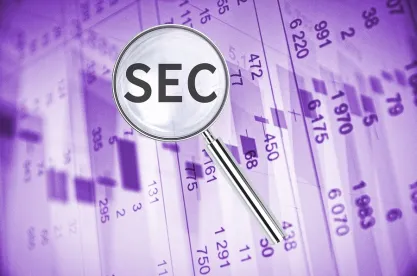The Securities and Exchange Commission (SEC) recently adopted amendments to the accelerated filer and large accelerated filer definitions in Rule 12b-2 under the Securities Exchange Act of 1934 (the Exchange Act). The final amendments, which can be found here:[1]
-
Exclude certain low-revenue smaller reporting companies (SRCs) that meet the SRC revenue test (currently annual revenues of less than $100 million (or $80 million if requalifying)) from the definition of each of accelerated filer and large accelerated filer;
-
Increase the public float transition thresholds for (i) exiting accelerated and large accelerated filer status to become a non-accelerated filer, and (ii) exiting large accelerated filer status to become an accelerated filer;[1]
-
Add the SRC revenue test to the public float transition thresholds for exiting from either accelerated filer or large accelerated filer status as an alternative determination; and
-
Add a check box to the cover pages of Forms 10-K, 20-F, and 40-F to indicate whether an internal control over financial reporting (ICFR) auditor attestation is included in the filing.
The final amendments became effective on April 27, 2020, and apply to annual report filings due on or after such date. For calendar fiscal year companies, which are the majority of public companies, their first periodic report to be filed using these revised definitions will be their annual report for the fiscal year ended December 31, 2020, and all subsequent reports filed in 2021 (collectively, 2021 periodic reports).
However, while the reassessment of an issuer’s filer status (i.e., whether a non-accelerated, accelerated, or large accelerated filer) is technically assessed at the end of the fiscal year, an issuer will know its filer status for the following year as of the end of its second fiscal quarter. Specifically, a calendar fiscal year company that is assessing its filer status as of December 31, 2020, will consider its annual revenues for the fiscal year ended December 31, 2019,[2] and its public float as of June 30, 2020. The determination of filer status governs the deadlines and other accommodations for an issuer’s 2021 periodic reports. If an issuer qualifies as a non-accelerated filer that has not qualified in the past, it may be able to recognize cost savings during 2020 as discussed in more detail below and may want to factor in its 2021 filer status in, for example, 2021 periodic report drafting and filing deadlines and board meeting calendar planning. Given the events thus far in 2020, there is increased volatility in the financial markets and many issuers are seeing significant fluctuations in the trading price of their common stock; therefore, we may see more issuers change filer status for 2021 periodic reporting than in the past, especially in light of these final amendments.
Quick Recap of the Determinations of Smaller Reporting Company Status and Filer Status
To determine its filing deadlines and disclosure obligations for each fiscal year, an issuer must assess both (i) its filer status for the year (whether it is a non-accelerated, accelerated, or large accelerated filer) and (ii) whether it is eligible for SRC status permitting certain scaled disclosure accommodations. An issuer’s filer status establishes its SEC filing schedule for the following year (when filings are due) and whether it is required to have an ICFR auditor attestation, while SRC status governs the level of disclosure that the issuer must provide (the substance of the filing).
An issuer makes an initial determination of its filer and SRC status (typically upon becoming a public company) and then reassesses its status each year. The transition thresholds for making the annual reassessment of whether the issuer is exiting status as an accelerated filer or a large accelerated filer or qualifying as an SRC are set at 80% of the corresponding initial qualification thresholds. SRC status is determined as of the end of the second fiscal quarter while filer status is determined as of the end of the fiscal year, but under the final amendments, both are now based on the issuer’s public float calculated as of the last business day of the most recently completed second fiscal quarter, and, as applicable, based on the issuer’s annual revenues as of the most recently completed fiscal year for which audited financial statements are available.[3]
As discussed in our prior client alert, in June 2018, the SEC amended the definition of “smaller reporting company” to increase the threshold for the public float test and expand the revenue test, one result of which was that some issuers are categorized as both an SRC and either an accelerated filer or a large accelerated filer (whereas, prior to the 2018 amendment, the SRC category of filers generally did not overlap with either the accelerated filer or large accelerated filer categories). Issuers that are categorized as both an SRC and either an accelerated filer or a large accelerated filer are able to avail themselves of the scaled disclosure requirements but must comply with (i) the earlier filing deadlines applicable to an accelerated filer or a large accelerated filer, as applicable, and (ii) the ICFR attestation report requirement.
Under the final amendments, the definitions of SRC and non-accelerated filer still do not fully align; specifically, some issuers will still be categorized as both SRCs and either an accelerated filer or a large accelerated filer. This client alert discusses in more detail the final amendments to the definitions of “accelerated filer” and “large accelerated filer” below. However, since the categories of filers still overlap after these final amendments, Annex B provides the initial and transition thresholds for determining whether an issuer is an SRC as well as an issuer’s filer status (i.e., large accelerated filer, accelerated filer, or non-accelerated filer), demonstrating how these categories overlap.
Exclusion of Low-Revenue SRCs and Business Development Companies from Definitions of Accelerated and Large Accelerated Filers
The final amendments provide a carve-out from the accelerated filer and large accelerated filer definitions, which provides that any issuer eligible to be an SRC[4] and that had annual revenues of less than $100 million in the most recently completed fiscal year for which audited financial statements are available will be a non-accelerated filer.
The final amendments also have a specific provision applicable to business development companies to provide analogous treatment since business development companies are not eligible to be SRCs, and provide a definition of “revenue” for business development companies to use in an initial determination or reassessment of filer status.
Changes to Transition Thresholds for Exiting Accelerated Filer or Large Accelerated Filer Status
The final amendments also increase the public float transition thresholds for (i) an accelerated filer or large accelerated filer to become a non-accelerated filer from $50 million to $60 million and (ii) a large accelerated filer to become an accelerated filer from $500 million to $560 million. The final amendments also added a revenue threshold[5] to the transition thresholds for exiting both accelerated and large accelerated filer status as an alternative determination.
What Is the Benefit of Being a Non-accelerated Filer?
Non-accelerated filers are not subject to the ICFR auditor attestation requirement of Section 404(b) of the Sarbanes-Oxley Act, which requires an issuer’s independent auditor to attest to, and report on, management’s assessment of the effectiveness of the issuer’s ICFR. An SRC that determines it is eligible to be a non-accelerated filer under the final amendments will not be subject to the ICFR auditor attestation requirement for its annual report due and submitted after the effective date of the final amendments (which for a calendar year-end company is its annual report for the year ended December 31, 2020). Also, note that the final amendments added a check box to the cover pages of annual reports on Forms 10-K, 20-F, and 40-F to indicate whether an ICFR auditor attestation is included in the filing.
However, such issuers will still be subject to important investor protection requirements. The issuers’ principal executive and financial officers must continue to certify that, among other things, they are responsible for establishing and maintaining ICFR and have evaluated and reported on the effectiveness of the issuer’s disclosure controls and procedures. In addition, these issuers will continue to be subject to a financial statement audit by an independent auditor, who is required to consider ICFR in the performance of that audit.
In addition, non-accelerated filers benefit from later filing deadlines. Specifically, non-accelerated filers have 90 days (instead of 75 or 60, as applicable) and 45 days (instead of 40) after period-end to file Form 10-Ks and Form 10-Qs, respectively.
What Issuers Should Be Doing Now
If you are a calendar fiscal year issuer, you should prepare to determine your public float calculation[6] as of June 30, 2020 (which is the last business day of the most recently completed second fiscal quarter). Issuers will use this calculation to reassess their filer status (i.e., whether a non-accelerated, accelerated, or large accelerated filer) at the end of the upcoming fiscal year in order to determine the deadline and other accommodations for their 2021 periodic reports. For example, a calendar fiscal year company that is reassessing its filer status as of December 31, 2020, will consider its annual revenues for the fiscal year ended December 31, 2019, and its public float calculation as of June 30, 2020, to confirm whether it qualifies as a non-accelerated filer for its 2021 periodic reports. An issuer that determines it is eligible to be a non-accelerated filer under the final amendments is not subject to the ICFR auditor attestation requirement for its annual report for the year ended December 31, 2020, and may comply with the filing deadlines that apply, and take advantage of the other accommodations available, to non-accelerated filers beginning with such report.
In addition, if a calendar fiscal year company determines it will be a non-accelerated filer upon its next reassessment of its filer status after calculating its public float as of June 30, 2020, we recommend that management, in consultation with the audit committee, determine as soon as possible whether it will want to take advantage of not including an ICFR auditor attestation in its 2020 annual report. Assuming the issuer does want to take advantage, it should review the scope of its external and, if applicable, internal auditor engagements for 2020 and possibly renegotiate such engagements, which may include a fee reduction.
Issuers should focus on these final amendments now in the event they will qualify as both an SRC and non-accelerated filer, so that they can take advantage of the benefits as soon as possible. An issuer qualifying as a non-accelerated filer will want to receive as soon as possible any resulting cost saving from not including an ICFR auditor attestation report and consider additional time provided for 2021 periodic reports when planning, for example, financial reporting deadlines, disclosure committee meetings, and board and committee meetings.
Annex A
Redline of Final Amendment to “Accelerated Filer” and “Larged Accelerated Filer” Definitions in Rule 12b-2 of the Exchange Act; and Current “Smaller Reporting Company” Definition in Rule 12b-2 of the Exchange Act
Accelerated Filer and Large Accelerated Filer.
(1) Accelerated Filer. The term accelerated filer means an issuer after it first meets the following conditions as of the end of its fiscal year:
(i) The issuer had an aggregate worldwide market value of the voting and non-voting common equity held by its non-affiliates of $75 million or more, but less than $700 million, as of the last business day of the issuer's most recently completed second fiscal quarter;
(ii) The issuer has been subject to the requirements of section 13(a) or 15(d) of the Act (15 U.S.C. 78m or 78o(d)) for a period of at least twelve calendar months; and
(iii) The issuer has filed at least one annual report pursuant to section 13(a) or 15(d) of the Act; and
(iv) The issuer is not eligible to use the requirements for smaller reporting companies under the revenue test in paragraph (2) or (3)(iii)(B) of the “smaller reporting company” definition in this section, as applicable.
(2) Large Accelerated Filer. The term large accelerated filer means an issuer after it first meets the following conditions as of the end of its fiscal year:
(i) The issuer had an aggregate worldwide market value of the voting and non-voting common equity held by its non-affiliates of $700 million or more, as of the last business day of the issuer's most recently completed second fiscal quarter;
(ii) The issuer has been subject to the requirements of section 13(a) or 15(d) of the Act for a period of at least twelve calendar months; and
(iii) The issuer has filed at least one annual report pursuant to section 13(a) or 15(d) of the Act; and
(iv) The issuer is not eligible to use the requirements for smaller reporting companies under the revenue test in paragraph (2) or (3)(iii)(B) of the “smaller reporting company” definition in this section, as applicable.
(3) Entering and Exiting Accelerated Filer and Large Accelerated Filer Status.
(i) The determination at the end of the issuer's fiscal year for whether a non-accelerated filer becomes an accelerated filer, or whether a non-accelerated filer or accelerated filer becomes a large accelerated filer, governs the deadlines for the annual report to be filed for that fiscal year, the quarterly and annual reports to be filed for the subsequent fiscal year and all annual and quarterly reports to be filed thereafter while the issuer remains an accelerated filer or large accelerated filer.
(ii) Once an issuer becomes an accelerated filer, it will remain an accelerated filer unless: The issuer determines,at the end of a fiscal year, that the aggregate worldwide market value of the voting and non-voting common equity held by its non-affiliates of the issuer was less than $60 50 million, as of the last business day of the issuer’s most recently completed second fiscal quarter; or it determines that it is eligible to use the requirements for smaller reporting companies under the revenue test in paragraph (2) or (3)(iii)(B) of the “smaller reporting company” definition in this section, as applicable. An issuer that makes either of these determinations making this determination becomes a non-accelerated filer. The issuer will not become an accelerated filer again unless it subsequently meets the conditions in paragraph (1) of this definition.
(iii) Once an issuer becomes a large accelerated filer, it will remain a large accelerated filer unless: It the issuerdetermines, at the end of a fiscal year, that the aggregate worldwide market value of the voting and non-voting common equity held by its non-affiliates of the issuer (“aggregate worldwide market value”) was less than $560 500 million, as of the last business day of the issuer’s most recently completed second fiscal quarter or it determines that it is eligible to use the requirements for smaller reporting companies under the revenue test in paragraph (2) or (3)(iii)(B) of the “smaller reporting company” definition in this section, as applicable. If the issuer’s aggregate worldwide market value was $60 50 million or more, but less than $560 500 million, as of the last business day of the issuer’s most recently completed second fiscal quarter, and it is not eligible to use the requirements for smaller reporting companies under the revenue test in paragraph (2) or (3)(iii)(B) of the “smaller reporting company” definition in this section, as applicable, it the issuer becomes an accelerated filer. If the issuer’s aggregate worldwide market value was less than $60 50 million, as of the last business day of the issuer’s most recently completed second fiscal quarter, or it is eligible to use the requirements for smaller reporting companies under the revenue test in paragraph (2) or (3)(iii)(B) of the “smaller reporting company” definition in this section, it the issuer becomes a non-accelerated filer. An issuer will not become a large accelerated filer again unless it subsequently meets the conditions in paragraph (2) of this definition.
(iv) The determination at the end of the issuer's fiscal year for whether an accelerated filer becomes a non-accelerated filer, or a large accelerated filer becomes an accelerated filer or a non-accelerated filer, governs the deadlines for the annual report to be filed for that fiscal year, the quarterly and annual reports to be filed for the subsequent fiscal year and all annual and quarterly reports to be filed thereafter while the issuer remains an accelerated filer or non-accelerated filer.
(4) For purposes of paragraph (1), (2), and (3) of this definition only, a business development company is considered to be eligible to use the requirements for smaller reporting companies under the revenue test in paragraph (2) or (3)(iii)(B) of the “smaller reporting company” definition in this section, provided that the business development company meets the requirements of the test using annual investment income under Rule 6-07.1 of Regulation S-X (17 CFR 210.6-07.1) as the measure of its “annual revenues” for purposes of the test.
Smaller Reporting Company.
As used in this part, the term smaller reporting company means an issuer that is not an investment company, an asset-backed issuer (as defined in § 229.1101 of this chapter), or a majority-owned subsidiary of a parent that is not a smaller reporting company and that:
(1) Had a public float of less than $250 million; or
(2) Had annual revenues of less than $100 million and either:
(i) No public float; or
(ii) A public float of less than $700 million.
(3) Whether an issuer is a smaller reporting company is determined on an annual basis.
(i) For issuers that are required to file reports under section 13(a) or 15(d) of the Exchange Act:
(A) Public float is measured as of the last business day of the issuer’s most recently completed second fiscal quarter and computed by multiplying the aggregate worldwide number of shares of its voting and non-voting common equity held by non-affiliates by the price at which the common equity was last sold, or the average of the bid and asked prices of common equity, in the principal market for the common equity;
(B) Annual revenues are as of the most recently completed fiscal year for which audited financial statements are available; and
(C) An issuer must reflect the determination of whether it came within the definition of smaller reporting company in its quarterly report on Form 10-Q for the first fiscal quarter of the next year, indicating on the cover page of that filing, and in subsequent filings for that fiscal year, whether it is a smaller reporting company, except that, if a determination based on public float indicates that the issuer is newly eligible to be a smaller reporting company, the issuer may choose to reflect this determination beginning with its first quarterly report on Form 10-Q following the determination, rather than waiting until the first fiscal quarter of the next year.
(ii) For determinations based on an initial registration statement under the Securities Act or Exchange Act for shares of its common equity:
(A) Public float is measured as of a date within 30 days of the date of the filing of the registration statement and computed by multiplying the aggregate worldwide number of shares of its voting and non-voting common equity held by non-affiliates before the registration plus, in the case of a Securities Act registration statement, the number of shares of its voting and non-voting common equity included in the registration statement by the estimated public offering price of the shares;
(B) Annual revenues are as of the most recently completed fiscal year for which audited financial statements are available; and
(C) The issuer must reflect the determination of whether it came within the definition of smaller reporting company in the registration statement and must appropriately indicate on the cover page of the filing, and subsequent filings for the fiscal year in which the filing is made, whether it is a smaller reporting company. The issuer must re-determine its status at the end of its second fiscal quarter and then reflect any change in status as provided in paragraph (3)(i)(C) of this definition. In the case of a determination based on an initial Securities Act registration statement, an issuer that was not determined to be a smaller reporting company has the option to re-determine its status at the conclusion of the offering covered by the registration statement based on the actual offering price and number of shares sold.
(iii) Once an issuer determines that it does not qualify for smaller reporting company status because it exceeded one or more of the current thresholds, it will remain unqualified unless when making its annual determination either:
(A) It determines that its public float was less than $200 million; or
(B) It determines that its public float and its annual revenues meet the requirements for subsequent qualification included in the following chart:
|
Prior Annual Revenues |
Prior Public Float |
|
|
None or less than $700 million |
$700 million or more |
|
|
Less than $100 million |
Neither threshold exceeded |
Public Float: Less than $560 million; and |
|
$100 million or more |
Public float: None or less than $700 million; and |
Public Float: Less than $560 million; and |
Annex B
Relationships Between Smaller Report Company (SRC) Status and Filer Status
Under the Final Amendments
The following tables demonstrate the relationships between SRC status and filer status under the final amendments. As noted in the client alert, under the final amendments, the definitions of SRC and non-accelerated filers still do not fully align. Note these tables do not contemplate every scenario when making a determination of filer or SRC status using the initial or transition thresholds referenced in the final two tables of Annex B. If you have any questions relating to making a determination of SRC or filer status, please contact Alexandra Layfield or Victoria Bagot.
Initial Determination of SRC Status and Filer Status
|
Status |
Public Float |
Annual Revenues |
ICFR Attestation |
|
SRC and |
Less than $75 million |
Not relevant |
No |
|
SRC and |
Less than $700 million |
Less than $100 million |
No |
|
SRC and |
$75 million to less than $250 million |
$100 million or more |
Yes |
|
Accelerated Filer |
$250 million to less than $700 million |
$100 million or more |
Yes |
|
Large Accelerated Filer |
$700 million or more |
Not relevant |
Yes |
Subsequent Determination of Filer Status:
Exiting Non-Accelerated Filer Status and Subsequently Re-Entering Either Accelerated Filer or Large Accelerated Filer Status
|
Status |
Subsequent Public Float |
Subsequent Annual Revenues |
ICFR Attestation |
|
Previously a Non-Accelerated Filer Becomes an Accelerated Filer |
$200 million to less than $700 million |
$100 million or more |
Yes |
|
Previously a Non-Accelerated or an Accelerated Filer Becomes a Large Accelerated Filer |
$700 million or more |
Not relevant |
Yes |
Subsequent Determination of Filer Status:
Exiting Large Accelerated or Accelerated Filer Status
(1) Public Float Transition Thresholds
|
Status |
Subsequent Public Float |
ICFR Attestation Report Required |
|
Previously a Large Accelerated Filer: Becomes an Accelerated Filer |
$200 million to less than $560 million |
Yes |
|
Previously an Accelerated or a Large Accelerated Filer Becomes an SRC and (becomes or remains) an Accelerated Filer |
$60 million to less than $200 million |
Yes |
|
Previously an Accelerated or a Large Accelerated Filer Becomes an SRC and a Non-Accelerated Filer |
Less than $60 million |
No |
(2) Revenue Transition Thresholds
|
Status |
Subsequent Public Float |
Subsequent Annual Revenues |
ICFR Attestation |
|
Previously a Large Accelerated Filer Becomes an SRC and a Non-Accelerated Filer |
Less than $560 million |
Less than $100 million* |
No |
|
Previously a Large Accelerated Filer Becomes an SRC and a Non-Accelerated Filer |
Less than $560 million |
Less than $80 million |
No |
|
Previously an Accelerated or a Large Accelerated Filer Becomes an SRC and a Non-Accelerated Filer |
Less than $700 million |
Less than $80 million |
No |
|
Previously an SRC Remains an SRC and becomes a Non-Accelerated Filer |
$60 million to less than $250 million |
Less than $100 million** |
No |
[1] The SEC also issued a helpful small entity compliance guide, which can be found here, specific to the definitions of accelerated filer and large accelerated filer. In addition, Annex A sets forth a marked version of the definitions of “accelerated filer” and “large accelerated filer” under Rule 12b-2 of the Exchange Act, showing the final amendments in more detail as well as the current definition of “smaller reporting company” under Rule 12b-2 for ease of reference.
[2] See hypotheticals provided on pages 53–54 of SEC Release No. 34-88365, which can be found here.
[3] Note this is based on its annual revenues in its most recent fiscal year completed before the last business day of the second fiscal quarter (i.e., the fiscal year that ended prior to the public float calculation and not the then-ended fiscal year) when making the filer determination. For example, for a calendar fiscal year company determining its filer status for its 2021 periodic reports, for both SRC and filer status determinations, the public float threshold will be based on the determination as of June 30, 2020, and the revenue threshold will be based on the annual revenues for the year ended December 31, 2019. See hypotheticals provided on pages 53–54 of SEC Release No. 34-88365, which can be found here.
[4] To be an SRC, the issuer must meet the existing requirements of having (i) a public float of less than $700 million as of the last business day of the issuer’s most recently completed second fiscal quarter, (ii) been subject to the reporting requirements of Section 13(a) or 15(d) of the Exchange Act for a period of at least 12 months, and (iii) filed at least one annual report with the SEC.
[5] Either annual revenues of less than $100 million or $80 million, as applicable, in the most recent fiscal year for which audited financial statements are available.
[6] An issuer calculates its public float (also known as “aggregate worldwide market value”) by multiplying the aggregate worldwide number of shares of its voting and non-voting common equity held by non-affiliates by the price at which the common equity was last sold, or the average of the bid and asked prices of common equity, in the principal market for the common equity.
* If revenues are below $100 million at initial determination and they never go above $100 million, the annual revenue threshold used for subsequent determinations of Non-accelerated filer status based on the revenue threshold test will be $100 million. See the revenue test in paragraph 3(iii)(B) of the “smaller reporting company” definition in Rule 12b-2.
** If public float is less than $250 million at initial determination and public float never goes above $250 million (so the issuer is an SRC at initial determination and remains an SRC), the annual revenue threshold used for subsequent determinations of Non-accelerated filer status based on the revenue threshold test will be $100 million. See the hypothetical provided on pages 53–54 of SEC Release No. 34-88365.







 />i
/>i

